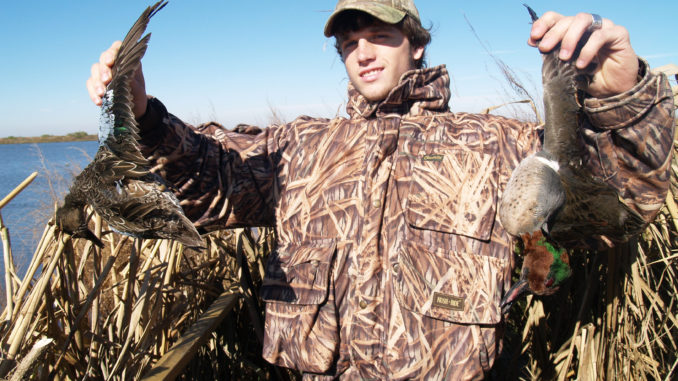
If the teal season is a taste of things to come, 2007 should be a banner year for Lake Salvador and Cataouatche duck hunters.
Spring surveys by the U.S. Fish and Wildlife Service recorded an overall duck population increase of 14 percent since last year. Most of those ducks will be flying south to Louisiana in the next couple of months.
And according fur and refuge division supervisor Todd Baker, these two St. Charles Parish lakes have the groceries to hold them.
“The Salvador management area itself is in really good shape as far as food. It hasn’t changed much in the last 3 years.” Baker says, “But in Lake Cataouatche, we are seeing significant changes every year.”
Baker was describing the phenomenal growth of hydrilla and other aquatic vegetation on the lake due to the Davis Pond diversion. “We’re seeing a 25 percent increase of vegetation over last year, and next year they’ll be even more.”
During teal season, hunters did exceptionally well in the lake itself, he added.
Hunters can legally build a blind on either lake as long as it’s made of natural material. “But it’s first come-first serve,” cautions the supervisor, “You cannot reserve a spot.”
Duck hunting will be spectacular with one caveat — as long as the diversion doesn’t open. “One thing a hunter has to consider is the diversion. We have the groceries but if they open up the diversion and put a foot of water over the food the ducks will leave.”
Fortunately for area duck hunters, the Corps is working on improvements and doesn’t plan to open the diversion this season.
Further west the grass isn’t as green — literally. Houma Point au Chene is going to do significantly better than last year due to increase in aquatics. “But outside of the impoundments we did not see the recovery that we expected.”
Baker said frequent strong tides didn’t allow vegetation to re-root in places swept clean from the storms.
Venice looks excellent.
Good news in the forecast
Forecasts of good duck hunting on Salvador WMA and Catouachi don’t stop with the habitat.
Baker is seeing more wood ducks than ever in the area. And our two most frequent visitors, blue-winged and green-winged teal, had record breeding seasons according to spring counts.
Blue-winged teal jumped 14 percent to an estimated 6.7 million birds. This is the third highest estimate since 1955 (48 percent above their long-term average).
Green-winged teal also increased 13 percent to 2.9 million birds (55 percent above the long-term average).
The successful breeding season was mainly due to improved habitat conditions on the breeding grounds.
“The 14 percent increase in breeding numbers for the 10 surveyed species is consistent with what Ducks Unlimited’s field biologists have observed across the U.S. and Canadian breeding grounds this spring,” said Ducks Unlimited’s Don Young.
One of the most important elements in duck-breeding success is the amount of water present on the prairie breeding grounds. When the survey was conducted in May, total pond counts for the United States and Canada combined showed 7 million ponds, a 15 percent increase from last year’s estimate, and 44 percent higher than the long-term average.
The mallard number is 10 percent higher than last year. An estimated 8 million mallards will fly south this year compared to last year’s estimate of 7.3 million birds.
The most positive news coming out of this year’s survey is that redheads, canvasbacks and northern shovelers are at record highs, and increases were also seen in two of three species of concern.
American wigeon numbers improved to 2.8 million (7 percent above the long-term average), and lesser scaup numbers improved slightly to 3.4 million. While this slight increase is a positive mark on a 20-year decline, scaup remain 33 percent below their long-term average.
Pintail numbers remained similar to last year (down 2 percent), and are still 19 percent below the long-term average. However, this year’s excellent habitat conditions could benefit pintail recruitment.
“It was extremely wet across the southern prairies and parklands in general, and the core pintail breeding areas in Saskatchewan, in particular,” said Yaich.
Nine of the 10 surveyed species increased this year. There was an estimated 3.4 million breeding gadwall on the survey area. This boosts their population by 19 percent since last year and 96 percent above the long-term average.
For the second year, redheads also increased 10 percent to 1 million birds (60 percent above the long-term average).
Canvasbacks increased by 25 percent. Now an estimated 865,000 breeding birds are on the survey area, a healthy 53 percent above their long-term average.
Northern shovelers are at an all-time high. With 4.6 million northern shovelers on the prairies, their numbers are 106 percent above the long-term average.
“Pintail and scaup continue to be well below their long-term averages, and remain a significant concern,” said Yaich.




Be the first to comment